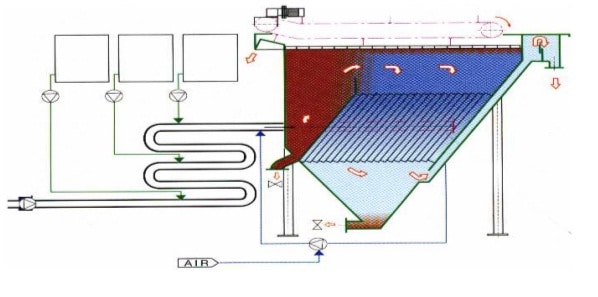Dissolved Air Flotation (DAF) System : Dissolved Air Flotation (DAF) is a Physio-Chemical Treatment where air is intimately contacted with an aqueous stream at high pressure, dissolving the air. The pressure on the liquid is reduced through a back pressure valve, thereby releasing micron-sized bubbles that sweep suspended solids and oil from the polluted stream to the surface of the air-flotation unit.
Applications include treating effluents from refinery API separators, metal finishing, pulp and paper industry, cold-rolling mill, poultry processing, grease recovery in meat-packing plants, cooking-oil separation from French-fry processing and some dairy industries. An increasingly important application is the thickening of sludge.
DAF units usually remove oil down to 5 ppm or less, and the released air may have to be treated in a control unit.
DAF units are generally sized with an overflow rate of 1500 to 3000 gal./day/sq.ft. and a retention time of 30 to 40 minutes.
A variant of the DAF unit that is commonly used in oil fields and for ballast water treatment is the Induced Air Flotation (IAF) unit. In the past it was rarely used in chemical plants and refineries but interest in it is increasing because the unit is totally enclosed and can use recycled gases for flotation. The unit utilizes polymer feed and usually has four eggbeater type frothing units for flotation. The unit has high power consumption, but uses much less space than a DAF unit. It is as efficient or more efficient than a DAF unit depending on oil and emulsion characteristics.
Attachment of gas bubbles to suspended-solids/gas mixture is carried to the vessel surface after precipitation of air on the particle, collision of a rising bubble with a suspended particle, trapping of gas bubbles as they rise under a floc particle and adsorption of the gas by a floc formed or precipitated around the air bubble.
To dissolve air for flotation, three types of pressurized systems are used. Full-flow or total pressurization is used when the wastewater contains large amounts of oily material. The intense mixing occurring in the pressurization system does not affect the treatment results. Partial-flow pressurization is used where moderate to low concentrations of oily material is present. Again, intense mixing by passage through the pressurization systems does not affect treatment efficiency significantly. The recycle-flow pressurization system is for treatment of solids or oily materials that would degrade by the intense mixing in the other pressurization systems. This approach is used following chemical treatment of oil emulsions, or for clarification and thickening of flocculent suspensions.
In the schematic drawing of dissolved-air flotation system shown in the figure, The solids-laden or oily-water in-fluent mixture enters the flotation vessel, and the air-solids mixture rises to the liquid surface. The air-solids mixture has a specific gravity less than water. Solids having a specific gravity greater than water tend to settle to the bottom and are removed by a rotating scraper arm. Attached to the same shaft is a rotating skimmer blade that removes the floating matter from the surface of the vessel into a skimming hopper. Clean water passes underneath a skirt and then must leave the vessel through a launder, which is located in the peripheral region.
A portion of the effluent water is recycled for pressurization. Compressed air is introduced into the discharge of the recycle pump, and intimate contact with the water is achieved in the aeration tank. Maximum solubilization efficiency is important at this point. The aerated recycle water is then returned through a back-pressure valve, where the pressurized air is released, and mixed with the in-fluent for flotation.
Flocculants such as synthetic polymers may be used to improve the effectiveness of dissolved air flotation. Also coagulants such as filter alum may be used to break emulsified oils and to coagulate materials for improved flotation recovery. DAF unit is equipped sometimes with a Lamella plate as shown in the figure which increases the separation area, and to ensure that even the smallest flocs are removed from the wastewater.

